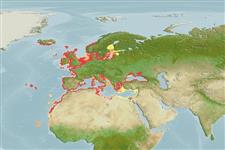>
Beloniformes (Needle fishes) >
Belonidae (Needlefishes)
Etymology: Belone: Greek, belone = needle; any fish with sharp pointed snout; also Pierre Belon, 1517-64, French zoologist born in Le Mans. Professor at the College de France, author of " La nature et diversité des poissons", 1551 (Ref. 45335).
More on author: Linnaeus.
Environment: milieu / climate zone / depth range / distribution range
Ecología
marino; salobre; oceanodromo (Ref. 51243); rango de profundidad 2 - 22 m (Ref. 130220). Temperate; 65°N - 14°N, 32°W - 42°E
Eastern Atlantic and Mediterranean Sea. Three subspecies were recognized by Collette and Parin (1970, Ref. 34977) Belone belone belone (Linnaeus, 1761) (Northeast Atlantic); Belone belone euxini Günther, 1866 (Black Sea and Sea of Azov); Belone belone acus Risso, 1827 (Mediterranean Sea and adjacent parts of Atlantic Ocean, Madeira, Canary Islands, Azores, and south to Cape Verde (Ref. 50279); subspecies Belone belone gracilis Lowe, 1839 (France to the Canary Islands including the Mediterranean) in Collette & Parin, 1990 (Ref. 5757).
Length at first maturity / Tamaño / Peso / Age
Maturity: Lm ? range ? - ? cm
Max length : 104 cm TL macho / no sexado; (Ref. 123983); common length : 45.0 cm SL macho / no sexado; (Ref. 3397); peso máximo publicado: 1.4 kg (Ref. 113079)
Espinas dorsales (total): 0; Radios blandos dorsales (total): 16-20; Radios blandos anales: 19 - 23. Jaw teeth comparatively large and widely spaced. Vertebrae 75-84. Vomerine teeth present at lengths greater than 20 cam. Lower jaw a little longer than upper jaw. Juveniles with greatly elongated jaw, without black posterior dorsal fin lobe.
Lives close to the surface and has a migratory pattern similar to the mackerel (Ref. 35388). Feeds on small fishes, particularly clupeids and Engraulis (in the Black Sea). Leaps out of the water when hooked. Oviparous (Ref. 205). Eggs may be found attached to objects in the water by tendrils on the egg's surface (Ref. 205). Utilized fresh and frozen; can be fried, broiled and baked (Ref. 9988). Minimum depth reported taken from Ref. 130219.
Collette, B.B. and N.V. Parin, 1986. Belonidae. p. 604-609. In P.J.P. Whitehead, M.-L. Bauchot, J.-C. Hureau, J. Nielsen and E. Tortonese (eds.) Fishes of the north-eastern Atlantic and the Mediterranean, Volume 2. Unesco, Paris. (Ref. 5505)
IUCN Red List Status (Ref. 130435)
Threat to humans
Harmless
Human uses
Pesquerías: comercial; pesca deportiva: si
Herramientas
Special reports
Download XML
Fuentes de Internet
Estimates based on models
Preferred temperature (Ref.
123201): 8.8 - 20, mean 11.3 °C (based on 548 cells).
Phylogenetic diversity index (Ref.
82804): PD
50 = 0.6250 [Uniqueness, from 0.5 = low to 2.0 = high].
Bayesian length-weight: a=0.00105 (0.00085 - 0.00129), b=3.08 (3.02 - 3.14), in cm total length, based on LWR estimates for this species (Ref.
93245).
Nivel trófico (Ref.
69278): 4.2 ±0.4 se; based on diet studies.
Resiliencia (Ref.
120179): Medio, población duplicada en un tiempo mínimo de 1.4-4.4 años (tm=2; Fec=1000).
Prior r = 0.43, 95% CL = 0.29 - 0.65, Based on 5 stock assessments.
Fishing Vulnerability (Ref.
59153): Moderate to high vulnerability (49 of 100).
Climate Vulnerability (Ref.
125649): High vulnerability (58 of 100).
Nutrients (Ref.
124155): Calcium = 50.7 [17.3, 178.7] mg/100g; Iron = 0.407 [0.148, 0.981] mg/100g; Protein = 17.8 [15.7, 20.3] %; Omega3 = 0.702 [0.293, 1.650] g/100g; Selenium = 9.33 [3.62, 22.32] μg/100g; VitaminA = 18.6 [5.4, 78.0] μg/100g; Zinc = 0.482 [0.202, 0.927] mg/100g (wet weight); based on
nutrient studies.
